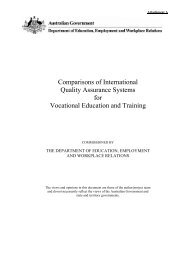National Survey of Research Commercialisation - Australian ...
National Survey of Research Commercialisation - Australian ...
National Survey of Research Commercialisation - Australian ...
Create successful ePaper yourself
Turn your PDF publications into a flip-book with our unique Google optimized e-Paper software.
Inventor involvement in licensing<br />
EXECUTIVE SUMMARY<br />
Inventor involvement appears to be an important element <strong>of</strong> strategies employed by<br />
universities, medical research institutes and CSIRO to manage their commercial licensing<br />
activities:<br />
In 73% <strong>of</strong> cases, inventors were either extremely involved or very involved in licensing<br />
activities.<br />
In only 5% <strong>of</strong> cases were inventors uninvolved in licensing activities.<br />
Start-up companies<br />
In total, 47 new start-up companies were formed in Year 2000 as a result <strong>of</strong> research<br />
conducted within the respondent institutions — <strong>of</strong> these, 91% had their headquarters<br />
in Australia.<br />
Of the 102 start-up companies that were reported to have been formed at any time<br />
as the result <strong>of</strong> research conducted within the respondent institutions, 101 were still<br />
operational at the end <strong>of</strong> Year 2000.<br />
Respondent institutions held equity in 63% <strong>of</strong> their start-up companies at the end <strong>of</strong><br />
Year 2000.<br />
COUNTRY COMPARISONS<br />
The <strong>National</strong> <strong>Survey</strong> <strong>of</strong> <strong>Research</strong> <strong>Commercialisation</strong> generated information about the<br />
extent <strong>of</strong> research commercialisation activity occurring in universities and medical<br />
research institutes in Australia.<br />
An analysis was undertaken to compare that information with information about<br />
commercial activities occurring in similar institutions in the USA and Canada.<br />
The indicators that were used to undertake the country comparisons were:<br />
number <strong>of</strong> US patents issued in Year 2000;<br />
number <strong>of</strong> licences executed in Year 2000;<br />
amount <strong>of</strong> adjusted gross income from licences in Year 2000; and<br />
number <strong>of</strong> start-up companies that were formed in Year 2000.<br />
Comparisons were made on the basis <strong>of</strong> ratios that express the value <strong>of</strong> each <strong>of</strong> these<br />
indicators relative to research expenditure and to gross domestic product (GDP),<br />
respectively.<br />
All financial amounts used in the calculation <strong>of</strong> these ratios are expressed in US$, on<br />
the basis <strong>of</strong> adjustments that were made to ensure purchasing power parity between<br />
amounts for the three countries.<br />
The amounts <strong>of</strong> GDP were also adjusted to account for differences in response rates<br />
<strong>of</strong> institutions in the three countries. This was not necessary in the case <strong>of</strong> research<br />
expenditure, since the expenditure used in the calculation <strong>of</strong> ratios for the comparisons<br />
was only that <strong>of</strong> the respondent institutions in the three countries.<br />
9

















